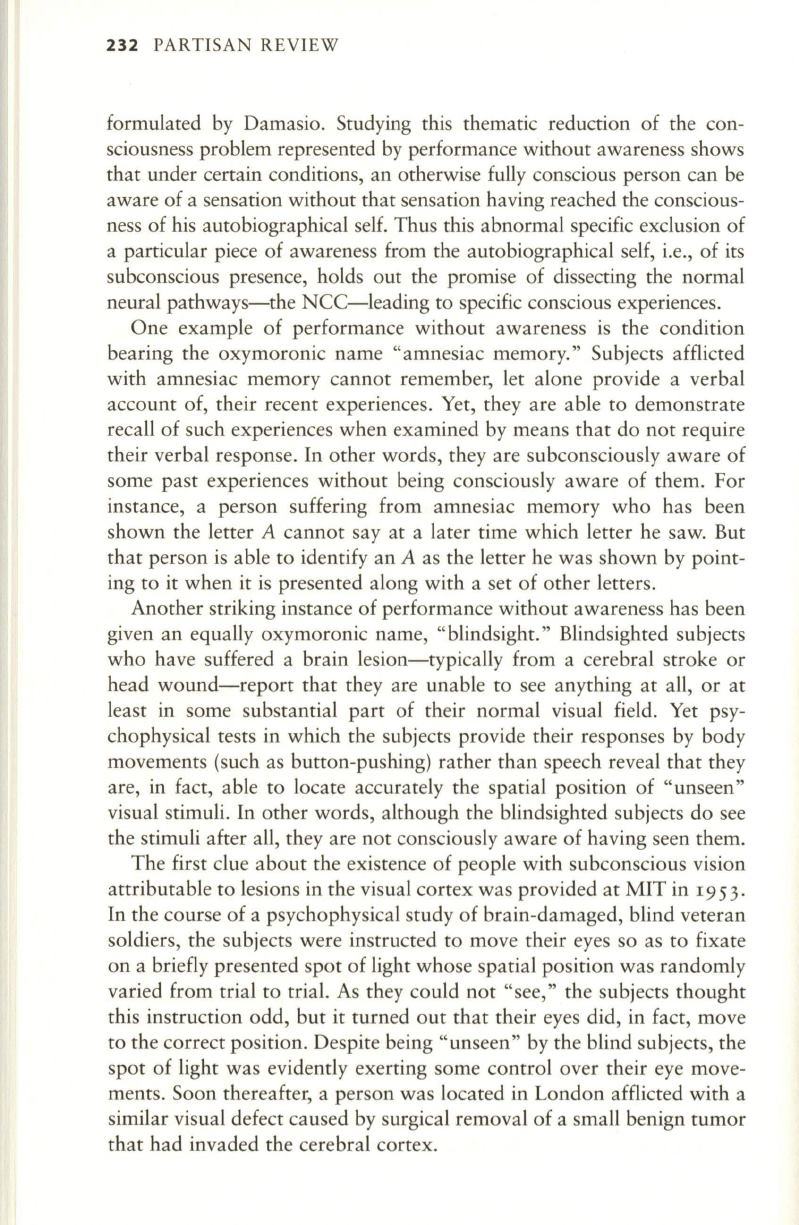
232
PARTISAN REVIEW
formulated by Damasio. Studying this thematic reduction of the con–
sciousness problem represented by performance without awareness shows
that under certain conditions, an otherwise fully conscious person can be
aware of a sensation without that sensation having reached the conscious–
ness of his autobiographical self. Thus this abnormal specific exclusion of
a particular piece of awareness from the autobiographical self, i.e., of its
subconscious presence, holds out the promise of dissecting the normal
neural pathways-the NCC-Ieading to specific conscious experiences.
One example of performance without awareness is the condition
bearing the oxymoronic name "amnesiac memory." Subjects afflicted
with amnesiac memory cannot remember, let alone provide a verbal
account of, their recent experiences. Yet, they are able to demonstrate
recall of such experiences when examined by means that do not require
their verbal response. In other words, they are subconsciously aware of
some past experiences without being consciously aware of them. For
instance, a person suffering from amnesiac memory who has been
shown the letter
A
cannot say at a later time which letter he saw. But
that person is able to identify an
A
as the letter he was shown by point–
ing to it when it is presented along with a set of other letters.
Another striking instance of performance without awareness has been
given an equally oxymoronic name, "blindsight." Blindsighted subjects
who have suffered a brain lesion-typically from a cerebral stroke or
head wound-report that they are unable
to
see anything at all, or at
least in some substantial part of their normal visual field. Yet psy–
chophysical tests in which the subjects provide their responses by body
movements (such as button-pushing) rather than speech reveal that they
are, in fact, able to locate accurately the spatial position of "unseen"
visual stimuli. In other words, although the blindsighted subjects do see
the stimuli after all, they are not consciously aware of having seen them.
The first clue about the existence of people with subconscious vision
attributable to lesions in the visual cortex was provided at MIT in
I953 .
In the course of a psychophysical study of brain-damaged, blind veteran
soldiers, the subjects were instructed to move their eyes so as to fixate
on a briefly presented spot of light whose spatial position was randomly
varied from trial to trial. As they could not "see," the subjects thought
this instruction odd, but it turned out that their eyes did, in fact, move
to the correct position. Despite being "unseen" by the blind subjects, the
spot of light was evidently exerting some control over their eye move–
ments. Soon thereafter, a person was located in London afflicted with a
similar visual defect caused by surgical removal of a small benign tumor
that had invaded the cerebral cortex.


